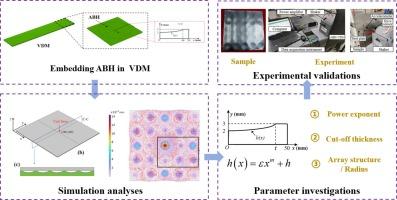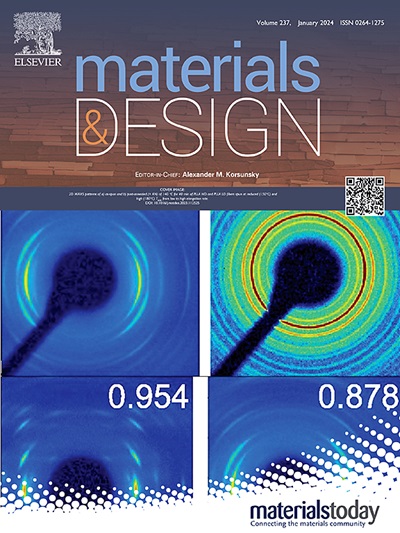Design of a lightweight broadband vibration reduction structure with embedded acoustic black holes in viscoelastic damping materials
IF 7.6
2区 材料科学
Q1 MATERIALS SCIENCE, MULTIDISCIPLINARY
引用次数: 0
Abstract
Viscoelastic damping materials (VDMs) are valued for their high damping characteristics in vibration and noise control. However, they typically underperform at lower frequencies and add substantial mass to structures. This study introduces an innovative approach by embedding an acoustic black hole (ABH) structure within VDMs (ABH-VDM) to achieve lightweight and broadband vibration damping. Firstly, a finite element method-based vibration model is developed to analyse the propagation and attenuation characteristics of vibrations in a plate strip embedded with ABH-VDM. This analysis provides insights into the dynamic behaviour and damping effectiveness of the proposed structure. Secondly, the study investigates the vibration reduction capabilities and mass implications of ABH-VDM on large-scale plate structures. The influence of ABH structural parameters, including the power exponent, cut-off thickness, and array configuration, is systematically investigated to optimize damping performance. Finally, experimental validation confirms that ABH-VDM achieves an additional 1.4 dB reduction in vibration across the entire frequency spectrum, with a bandwidth extension of 900 Hz. Moreover, ABH-VDM reduces mass by 8.6 %, demonstrating its potential for lightweight vibration control in structural applications. This research contributes valuable insights into advancing lightweight and broadband damping solutions for enhanced vibration management in engineering systems.

设计在粘弹性阻尼材料中嵌入声学黑洞的轻质宽带减震结构
粘弹性阻尼材料(VDM)因其在振动和噪音控制方面的高阻尼特性而备受推崇。然而,它们在低频时通常表现不佳,而且会增加结构的质量。本研究介绍了一种创新方法,即在 VDM(ABH-VDM)中嵌入声学黑洞(ABH)结构,以实现轻质、宽带的减振效果。首先,开发了一种基于有限元法的振动模型,用于分析嵌入 ABH-VDM 的板条中振动的传播和衰减特性。该分析有助于深入了解拟议结构的动态行为和阻尼效果。其次,本研究还探讨了 ABH-VDM 对大型板结构的减振能力和质量影响。系统地研究了 ABH 结构参数的影响,包括功率指数、截止厚度和阵列配置,以优化阻尼性能。最后,实验验证证实 ABH-VDM 在整个频谱范围内可额外减少 1.4 分贝的振动,带宽扩展至 900 Hz。此外,ABH-VDM 的质量减轻了 8.6%,证明了其在结构应用中进行轻质振动控制的潜力。这项研究为推进轻质宽带阻尼解决方案以增强工程系统的振动管理提供了宝贵的见解。
本文章由计算机程序翻译,如有差异,请以英文原文为准。
求助全文
约1分钟内获得全文
求助全文
来源期刊

Materials & Design
Engineering-Mechanical Engineering
CiteScore
14.30
自引率
7.10%
发文量
1028
审稿时长
85 days
期刊介绍:
Materials and Design is a multi-disciplinary journal that publishes original research reports, review articles, and express communications. The journal focuses on studying the structure and properties of inorganic and organic materials, advancements in synthesis, processing, characterization, and testing, the design of materials and engineering systems, and their applications in technology. It aims to bring together various aspects of materials science, engineering, physics, and chemistry.
The journal explores themes ranging from materials to design and aims to reveal the connections between natural and artificial materials, as well as experiment and modeling. Manuscripts submitted to Materials and Design should contain elements of discovery and surprise, as they often contribute new insights into the architecture and function of matter.
 求助内容:
求助内容: 应助结果提醒方式:
应助结果提醒方式:


